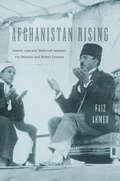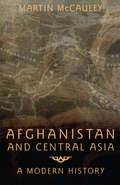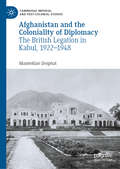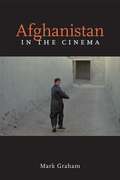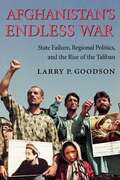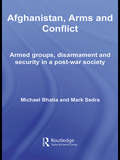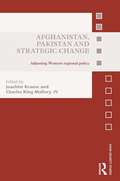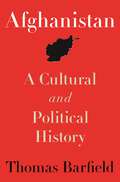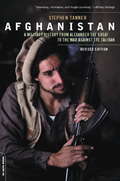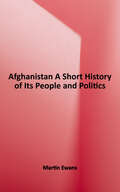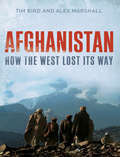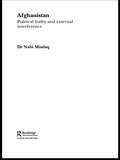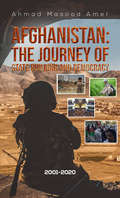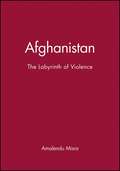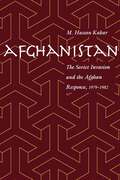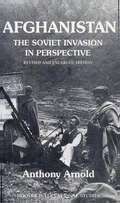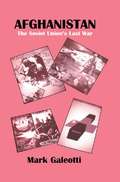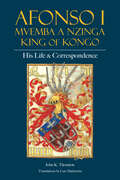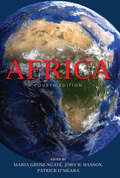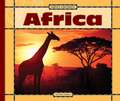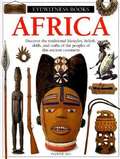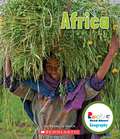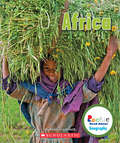- Table View
- List View
Afghanistan Rising: Islamic Law and Statecraft between the Ottoman and British Empires
by Faiz AhmedDebunking conventional narratives, Faiz Ahmed presents a vibrant account of the first Muslim-majority country to gain independence, codify its own laws, and ratify a constitution after the fall of the Ottoman Empire. Afghanistan, he shows, attracted thinkers eager to craft a modern state within the interpretive traditions of Islamic law and ethics.
Afghanistan and Central Asia: A Modern History
by Martin MccauleyThe Afghan crisis has grabbed the attention of the entire world, and underlined the desperate need in the West for a better understanding of the region and its challenges in the face of increasingly militant interpretations of Islam. Carved up and fought over by the British and Tsarist Russia in the nineteenth century, and under Soviet domination for much of the twentieth, the lonely passes, deserts and peoples of the five Central Asian republics have remained shrouded in obscurity. Even Afghanistan, the site of almost constant conflict since the Soviet invasion of 1978, is little known beyond the media images of the Islamic fundamentalist Taliban movement. Martin McCauley draws on his vast knowledge of the region and its history to provide a clear and highly readable account of Afghanistan and the Central Asian republics of Kazakhstan, Kyrgyzstan, Tasikistan, Turkmenistan, Uzbekistan, from their medieval pasts to the unpredictable present. Illuminating languages and landscapes, cultures and society, he examines the rise of militant Islam and its impact on the region, the push and pull of global economics and politics, and possibilities for stability in an inherently unstable part of the world.
Afghanistan and the Coloniality of Diplomacy: The British Legation in Kabul, 1922–1948 (Cambridge Imperial and Post-Colonial Studies Series)
by Maximilian DrephalThis book offers an institutional history of the British Legation in Kabul, which was established in response to the independence of Afghanistan in 1919. It contextualises this diplomatic mission in the wider remit of Anglo-Afghan relations and diplomacy from the nineteenth to the twenty-first century, examining the networks of family and profession that established the institution’s colonial foundations and its connections across South Asia and the Indian Ocean. The study presents the British Legation as a late imperial institution, which materialised colonialism's governmental practices in the age of independence. Ultimately, it demonstrates the continuation of asymmetries forged in the Anglo-Afghan encounter and shows how these were transformed into instances of diplomatic inequality in the realm of international relations. Approaching diplomacy through the themes of performance, the body and architecture, and in the context of knowledge transfers, this work offers new perspectives on international relations through a cultural history of diplomacy.
Afghanistan in the Cinema
by Mark GrahamIn this timely critical introduction to the representation of Afghanistan in film, Mark Graham examines the often surprising combination of propaganda and poetry in films made in Hollywood and the East. Through the lenses of postcolonial theory and historical reassessment, Graham analyzes what these films say about Afghanistan, Islam, and the West and argues that they are integral tools for forming discourse on Afghanistan, a means for understanding and avoiding past mistakes, and symbols of the country's shaky but promising future. Thoughtfully addressing many of the misperceptions about Afghanistan perpetuated in the West, Afghanistan in the Cinema incorporates incisive analysis of the market factors, funding sources, and political agendas that have shaped the films. The book considers a range of films, beginning with the 1970s epics The Man Who Would Become King and The Horsemen and following the shifts in representation of the Muslim world during the Russian War in films such as The Beast and Rambo III. Graham then moves on to Taliban-era films such as Kandahar, Osama, and Ellipsis, the first Afghan film directed by a woman. Lastly, the book discusses imperialist nostalgia in films such as Charlie Wilson's War and destabilizing visions represented in contemporary works such as The Kite Runner.
Afghanistan's Endless War: State Failure, Regional Politics, and the Rise of the Taliban
by Larry E. GoodsonState Failure, Regional Politics, and the rise of the Taliban
Afghanistan, Arms and Conflict: Armed Groups, Disarmament and Security in a Post-War Society (Contemporary Security Studies)
by Mark Sedra Michael Vinay BhatiaThis is the first book to provide a comprehensive assessment of small arms and security-related issues in post-9/11 Afghanistan. It includes case studies which reveal the findings of in-depth field research on hitherto neglected regions of the country, and provides a distinctive balance of thematic analysis, conceptual models and empirical research. Exploring various facets of armed violence and measures to tackle it, the volume provides significant insight into broader issues such as the efficacy of international assistance, the ‘shadow’ economy, warlordism, and the Taliban-led insurgency. In an effort to deconstruct and demystify Afghanistan’s alleged ‘gun culture’, it also explores some of the prevailing obstacles and opportunities facing the country in its transition period. In so doing, the book offers valuable lessons to the state-builders of Afghanistan as well as those of other countries and regions struggling to emerge from periods of transition. This book will be of much interest to all students of Afghanistan, small arms, insurgency, Asian Studies, and conflict studies in general.
Afghanistan, Pakistan and Strategic Change: Adjusting Western regional policy (Asian Security Studies)
by Iv Joachim Krause Charles King MalloryThe region encompassing Afghanistan and Pakistan (Af/Pak region) is undergoing a fundamental strategic change. This book analyses the nature of this strategic change, in ordre to seek possible future scenarios and to examine policy options. It also undertakes a critical review of the basic elements of the Western strategic approach towards dealing with regional conflicts in all parts of the world, with special emphasis on the Af/Pak region.Dealing with the political developments i one of the most volatile regions in the world – Afghanistan and Pakistan – the volume focuses on Western strategic concerns. The withdrawal of ISAF by 2014 will change the overall political setting and the work addresses the challenges that will result for Western policymakers thereafter. It examines the cases of Afghanistan and Pakistan separately, and also looks at the broader region and tries to identify different outcomes. This book will be of much interest to students of Central and South Asian politics, strategic studies, foreign policy and security studies generally.
Afghanistan: A Cultural and Political History
by Thomas BarfieldAfghanistan traces the historic struggles and the changing nature of political authority in this volatile region of the world, from the Mughal Empire in the sixteenth century to the Taliban resurgence today. Thomas Barfield introduces readers to the bewildering diversity of tribal and ethnic groups in Afghanistan, explaining what unites them as Afghans despite the regional, cultural, and political differences that divide them. He shows how governing these peoples was relatively easy when power was concentrated in a small dynastic elite, but how this delicate political order broke down in the nineteenth and twentieth centuries when Afghanistan's rulers mobilized rural militias to expel first the British and later the Soviets. Armed insurgency proved remarkably successful against the foreign occupiers, but it also undermined the Afghan government's authority and rendered the country ever more difficult to govern as time passed. Barfield vividly describes how Afghanistan's armed factions plunged the country into a civil war, giving rise to clerical rule by the Taliban and Afghanistan's isolation from the world. He examines why the American invasion in the wake of September 11 toppled the Taliban so quickly, and how this easy victory lulled the United States into falsely believing that a viable state could be built just as easily. Afghanistan is essential reading for anyone who wants to understand how a land conquered and ruled by foreign dynasties for more than a thousand years became the "graveyard of empires" for the British and Soviets, and what the United States must do to avoid a similar fate.
Afghanistan: A Cultural and Political History, Second Edition (Princeton Shorts Ser. #9)
by Thomas BarfieldA major history of Afghanistan and its changing political cultureAfghanistan traces the historic struggles and the changing nature of political authority in this volatile region of the world, from the Mughal Empire in the sixteenth century to the Taliban resurgence today. Thomas Barfield introduces readers to the bewildering diversity of tribal and ethnic groups in Afghanistan, explaining what unites them as Afghans despite the regional, cultural, and political differences that divide them. He shows how governing these peoples was relatively easy when power was concentrated in a small dynastic elite, but how this delicate political order broke down in the nineteenth and twentieth centuries when Afghanistan's rulers mobilized rural militias to expel first the British and later the Soviets. Armed insurgency proved remarkably successful against the foreign occupiers, but it also undermined the Afghan government's authority and rendered the country ever more difficult to govern as time passed. Barfield vividly describes how Afghanistan's armed factions plunged the country into a civil war, giving rise to clerical rule by the Taliban and Afghanistan's isolation from the world. He examines why the American invasion in the wake of September 11 toppled the Taliban so quickly, and how this easy victory lulled the United States into falsely believing that a viable state could be built just as easily.Afghanistan is essential reading for anyone who wants to understand how a land conquered and ruled by foreign dynasties for more than a thousand years became the "graveyard of empires" for the British and Soviets, and why the United States failed to avoid the same fate.
Afghanistan: A Military History from Alexander the Great to the War against the Taliban
by Stephen TannerFor over 2,500 years, the forbidding territory of Afghanistan has served as a vital crossroads for armies and has witnessed history-shaping clashes between civilizations: Greek, Arab, Mongol, and Tartar, and, in more recent times, British, Russian, and American. When U. S. troops entered Afghanistan in the weeks following September 11, 2001, they overthrew the Afghan Taliban regime and sent the terrorists it harbored on the run. But America’s initial easy victory is in sharp contrast to the difficulties it faces today in confronting the Taliban resurgence. Originally published in 2002, Stephen Tanner’s Afghanistan has now been completely updated to include the crucial turn of events since America first entered the country.
Afghanistan: A New History of the Borderland (Men-at-arms Ser. #No. 178)
by David IsbyA startling history of modern Afghanistan: the story of a country caught in a vortex of terror. Veteran defense analyst and Afghanistan expert David Isby provides an insightful and meticulously researched look at the current situation in Afghanistan, her history, and what he believes must be done so that the US and NATO coalition can succeed in what has historically been known as "the graveyard of empires." Afghanistan is one of the poorest countries in the world with one of the lowest literacy rates. It is rife with divisions between ethnic groups that dwarf current schisms in Iraq, and all the groups are lead by warlords who fight over control of the drug trade as much as they do over religion. The region is still racked with these confrontations along with conflicts between rouge factions from Pakistan, with whom relations are increasingly strained. After seven years and billions of dollars in aid, efforts at nation-building in Afghanistan has produced only a puppet regime that is dependent on foreign aid for survival and has no control over a corrupt police force nor the increasingly militant criminal organizations and the deepening social and economic crisis. The task of implementing an effective US policy and cementing Afghani rule is hampered by what Isby sees as separate but overlapping conflicts between terrorism, narcotics, and regional rivalries, each requiring different strategies to resolve. Pulling these various threads together will be the challenge for the Obama administration, yet it is a challenge that can be met by continuing to foster local involvement and Afghani investment in the region. This paperback edition includes a new 2011 afterword by the author.
Afghanistan: A Short History of Its People and Politics
by Martin EwansA fascinating chronicle of a nation's turbulent history. Reaching back to the earliest times, Martin Ewans examines the historical evolution of one of today's most dangerous breeding grounds of global terrorism. After a succession of early dynasties and the emergence of an Afghan empire during the eighteenth century, the nineteenth and early twentieth century saw a fierce power struggle between Russia and Britain for supremacy in Afghanistan that was ended by the nation's proclamation of independence in 1919. A communist coup in the late 1970s overthrew the established regime and led to the invasion of Soviet troops in 1979. <p><p>Roughly a decade later, the Soviet Union withdrew, condemning Afghanistan to a civil war that tore apart the nation's last remnants of religious, ethnic, and political unity. It was into this climate that the Taliban was born. Today, war-torn and economically destitute, Afghanistan faces unique challenges as it looks toward an uncertain future. Martin Ewans carefully weighs history lessons to provide a frank look at Afghanistan's prospects and the international resonances of the nation's immense task of total political and economic reconstruction.
Afghanistan: How the West Lost its Way
by Tim Bird Alex MarshallIn October 2001, NATO forces invaded Afghanistan. Their initial aim, to topple the Taliban regime and replace it with a more democratic government aligned to Western interests, was swiftly achieved. However, stabilizing the country in the ensuing years has proven much more difficult. Despite billions of dollars in aid and military expenditure, Afghanistan remains a nation riddled with warlords, the world's major heroin producer, and the site of a seemingly endless conflict between Islamist militants and NATO forces. In this timely and important book, Tim Bird and Alex Marshall offer a panoramic view of international involvement in Afghanistan from 2001 to 2011. Tackling the subject matter as a whole, Bird and Marshall weave together analysis of military strategy, regional context, aid policy, the Afghan government, and the many disagreements between and within the Western powers involved in the intervention. Given the complicating factors of the heroin trade, unwelcoming terrain, and precarious relations with Pakistan, the authors acknowledge the ways in which Afghanistan has presented unique challenges for its foreign invaders. Ultimately, however, they argue that the international community has failed in its self-imposed effort to solve Afghanistan's problems and that there are broader lessons to be learned from their struggle, particularly in terms of counterinsurgency and the ever-complicated work of "nation-building. " The overarching feature of the intervention, they argue, has been an absence of strategic clarity and coherence.
Afghanistan: Political Frailty and External Interference (Routledge Studies in Middle Eastern History)
by Nabi MisdaqAfghan society is analyzed from a fresh standpoint in this book which discusses the country’s two and a half centuries of socio-political disquiet and outside interference. The author explores the continuous struggle between the central government and the cornerstone of the present state, the tribes. In its examination of the interchange between the centre and the periphery, the book presents a compelling review of Afghan history, the role of Islam and the contemporary theories of state, Islam, nationalism, ethnicity, and tribalism. In addition, Misdaq considers Afghanistan’s dynamism and long established custom of dealing with foreign invaders. Covering the Soviet occupation, ethnic conflicts and the US invasion, the book examines Afghan resilience and the capacity to raise an army of fighting men. Written by a well-respected authority on the region, the book highlights past mistakes which should not be repeated and recommends the way forward for this troubled nation.
Afghanistan: The Journey of State Building and Democracy 2001-2020
by Ahmad Masood AmerThe Journey of State Building and Democracy in Afghanistan is a review of the state-building and democratic-governance process in the country which started after the US-led international intervention which toppled the Taliban regime and established a new government. This period marks a new era in the contemporary history of the country which it has never experienced before. From 1993-2001, the country was left deep in crisis and the world forgot Afghanistan after the collapse of the Soviet-backed regime in 1992 and creation of the Taliban. The nation experienced one of their darkest periods in history and the country was turned into a safe haven for international terrorism. After the 9/11, which shook the world, the country came back to international spot light. With support by the international community, reconstruction and development started and major investments were made in building state institutions and establishing democracy and freedom. With the global politics and foreign policy interest of the international allies constantly shifting, the country is again in a critical juncture. Albeit with relative success, there is fear that the country would backslide if international involvement is withdrawn. This book reviews the progress in institution building and the experience of democratic system of governance over the past two decades. It highlights critical points and lessons for the policy makers and the political elites to remedy the current situation and bring changes in as the country continues its journey.
Afghanistan: The Labyrinth of Violence
by Amalendu MisraAfghanistan has become synonymous with violence. In the past 25 years alone, the country has endured Russian invasion and occupation, civil war and a US-led military campaign, resulting in the combined loss of over 2 million lives, most of them civilian. Even now, following the overthrow of the Taliban regime, old ethnic animosities have resurfaced which seem likely to push the country into another spell of internal war. But why is it that Afghanistan has experienced such bloody conflict and slaughter? What factors have allowed the country to be exploited by external powers who have intervened to determine its politics, social structure and, consequently, its place in the world? In this fascinating new book, Amalendu Misra seeks to provide answers to these pressing questions. By analysing the nature of conflict in Afghanistan, he exposes the various geopolitical, ethnic, economic and religious variables which have contributed to the breakdown of the Afghan state, and ponders whether post-war reconstruction could lead to a more democratic and peaceful Afghanistan.
Afghanistan: The Soviet Invasion and the Afghan Response, 1979-1982
by Mohammed KakarFew people are more respected or better positioned to speak on the Soviet invasion of Afghanistan than M. Hassan Kakar. A professor at Kabul University and scholar of Afghanistan affairs at the time of the 1978 coup d'état, Kakar vividly describes the events surrounding the Soviet invasion in 1979 and the encounter between the military superpower and the poorly armed Afghans. The events that followed are carefully detailed, with eyewitness accounts and authoritative documentation that provide an unparalleled view of this historical moment.Because of his prominence Kakar was at first treated with deference by the Marxist government and was not imprisoned, although he openly criticized the regime. When he was put behind bars the outcry from scholars all over the world possibly saved his life. In prison for five years, he continued collecting information, much of it from prominent Afghans of varying political persuasions who were themselves prisoners.Kakar brings firsthand knowledge and a historian's sensibility to his account of the invasion and its aftermath. This is both a personal document and a historical one—Kakar lived through the events he describes, and his concern for human rights rather than party politics infuses his writing. As Afghans and the rest of the world try to make sense of Afghanistan's recent past, Kakar's voice will be one of those most listened to.
Afghanistan: The Soviet Invasion in Perspective
by Anthony ArnoldOn December 27, 1979, the USSR invaded Afghanistan to save an endangered communist regime. The People's Democratic Party of Afghanistan, founded in 1965 but almost immediately riven into two hostile wings, had been induced by Moscow into unifying in 1977 in order to seize power the following year. Within weeks, however, the majority Khalqi faction had driven out the rival Parchamis, only to discover that its rigid Marxism-Leninism was no match for Islam. As the Khalqi position deteriorated, Moscow thought to regain control by forceful replacement of the PDPA leaders with Parchamis. Instead, their invasion only consolidated popular determination to eject an alien ideology. In Afghanistan's Two-Party Communism, Anthony Arnold brings these dramatic developments to life, examining Parcham and Khalq in the context of the cultural, ethnic, and class factors that distinguish their leaders and separate constituencies. He analyzes the PDPA's development through 1982 and closes with speculation on the degree of Soviet commitment to communism in Afghanistan. Written in a lively, penetrating style, yet with a wealth of detail and analysis, Arnold's book reflects the intimate feel for the country that he acquired while serving there. His multilingual source material includes hitherto classified documents, and the appendixes (biographic sketches of PDPA leaders, translations of key party documents, charts of party and state personnel changes) will provide valuable sources for other researchers.
Afghanistan: The Soviet Union's Last War
by Mark GaleottiThe Soviet Union's last war was played out against the backdrop of dramatic change within the USSR. This is the first book to study the impact of the war on Russian politics and society. Based on extensive use of Soviet official and unofficial sources, as well as work with Afghan veterans, it illustrates the way the war fed into a wide range of other processes, from the rise of grassroots political activism to the retreat from globalism in foreign policy.
Afonso I Mvemba a Nzinga, King of Kongo: His Life and Correspondence
by John K. Thornton"John K. Thornton&’s new book is another must-read. It contains both translations of the extant letters of the most significant king of Kongo&’s history, Afonso I (r. 1506–1542), and a powerful, learned, and highly readable analysis of what these letters tell us about the life and times of one of the most important rulers anywhere in the world during the sixteenth century. This book will be essential reading for scholars, teachers, and students engaged with the history of the Kingdom of Kongo." —Toby Green, King&’s College London
Africa
by John H. Hanson Maria Grosz-Ngaté Patrick O’Meara“Much has changed in Africa and in African studies . . . but one constant has been the enduring excellence of the anthology Africa.” —International Journal of African Historical StudiesSince the publication of the first edition in 1977, Africa has established itself as a leading resource for teaching, business, and scholarship. This fourth edition has been completely revised and focuses on the dynamism and diversity of today’s Africa.The latest volume emphasizes contemporary culture–civil and social issues, art, religion, and the political scene–and provides an overview of significant themes that bear on Africa’s place in the world. Historically grounded, Africa provides a comprehensive view of the ways that African women and men have constructed their lives and engaged in collective activities at the local, national, and global levels.“From all indications, the fourth edition of Africa should not only endure the test of time, but also be found exceptionally useful by a wide spectrum of scholars, including college professors and their students in general.” —Africa Today
Africa (Earth's Continents)
by Mary LindeenEARTH'S CONTINENTS lets you begin exploring Earth's seven continents. Learn about each continent's land, people, animals, and cultures just by turning the pages! A very simple introduction to the geography, topography, flora, fauna, and people of Africa. Picture captions and descriptions present.
Africa (Rookie Read-About Geography)
by Rebecca E. Hirsch<p>Get ready for a fascinating trip around the seven continents of the world! Simple, engaging text and colorful, mesmerizing pictures teach you about each continent's land features, populations, native animals, technological advances, and lots more—including how to find each continent on a map! <p>Africa is a large and diverse continent, and young readers will love discovering the people, geography, and animals found there.</p>
Africa (Rookie Read-About Geography: Continents)
by Rebecca HirschAfrica is often called the Cradle of Humankind. Millions of years ago, it was home to the very first huma, and today it remains a vibrant land filled with diverse cultures. Rookie Read-About: Continents series gives the youngest reader (Ages 3-6) an introduction to the components that make each continent distinctive and exceptional. Readers will get to know each continents' geography, history, and wildlife.
